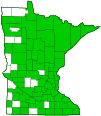Isabella tiger moth
(Pyrrharctia isabella)
Conservation • Description • Habitat • Ecology • Distribution • Taxonomy
| Hodges # | 8129 |
||
Conservation Status |
|||
| IUCN Red List | not listed |
||
| NatureServe | N5 - Secure |
||
| Minnesota | not listed |
||
Description
In its larval (caterpillar) stage, Isabella tiger moth may be the most widely recognized moth in North America. Folklore says that the size of the orange band predicts the severity of the coming winter, with wider bands forecasting a milder winter. This means of forecasting is probably as accurate as the Farmer’s Almanac, though perhaps not as accurate as the National Weather Service.
The adult is less conspicuous but equally distinctive. The adult moth has a wingspan of 1¼″ to 2″ and a total length of 15 ⁄16″ to 1 5 ⁄16″. The thorax is densely covered with long brown or yellowish-brown hairs. The abdomen is orange with an upper (dorsal) row of black spots.
The forewings are pointed and are uniformly light to medium orangish-brown. On some individuals there is a fringe of reddish-orange hairs on the outer margin. The veins are marked with faint brown spots. There is a series of black spots on the subterminal line and often one or more spots on the antemedial, median, and postmedial lines. The discal spot has a group of 3 to 5 black spots. The hindwing of males are pale orange with a black discal spot and black spots near the margin. The hindwing of females is pale rose but otherwise similar.
The caterpillar is up to 2″ long and is densely covered with stiff bristles (setae) from front to back. There are also a few longer, softer hairs extending from the front and back of the body. The setae are in clusters of several and are mostly uniform in length. On most caterpillars the setae are black on the head, thorax, and first few and last few abdominal segments; and orange on the middle abdominal segments. As the caterpillar ages and grows, it sheds its skin and setae (molts) several times. At each successive stage between molts (instar) it becomes more orange. On some individuals all of the setae are blond, brown, rust, or tan. There is a small breathing hole (spiracle) on both sides of each thoracic segment and all but the last abdominal segment. On pale individuals the spiracles are tan or white.
Size
Total length: 15 ⁄16″ to 1 5 ⁄16″
Wingspan: 1¾″ to 2½″
Similar Species
Habitat
Deciduous woodlands, prairies
Ecology
Season
One brood. Early June to late July.
Behavior
Caterpillars are especially mobile in the fall. When disturbed, they curl up into a ball.
Adults are nocturnal. They are attracted to lights.
Life Cycle
Eggs hatch after about two weeks. Caterpillars overwinter under leaf litter or other debris, where they freeze solid. In the spring they become active and resume feeding. After a few days then spin a cocoon to pupate. Adults emerge in about a month.
Larva Food/Hosts
Deciduous trees and a wide range of low growing herbaceous and woody plants.
Adult Food
Adults do not feed.
Distribution |
||
|
Sources 7, 21, 24, 27, 29, 30, 71, 75, 82, 83. Biodiversity occurrence data published by: Minnesota Biodiversity Atlas (accessed through the Minnesota Biodiversity Atlas Portal, bellatlas.umn.edu, 10/11/2025). |
|
| 10/11/2025 | ||
Occurrence |
||
Widespread and common |
||
Taxonomy
Order
Lepidoptera (Butterflies and Moths)
Superfamily
Noctuoidea (Owlet Moths and Allies)
Family
Erebidae (Underwing, Tiger, Tussock, and Allied Moths)
Subfamily
Arctiinae (tiger moths and allies)
Tribe
Arctiini (tiger moths)
Subtribe
Spilosomina
Genus
Pyrrharctia
Family
Until recently, tiger moths and lichen moths were treated as a separate family Arctiidae. A recently published monograph (Lafontaine and Schmidt, 2010) contended that the Arctiidae “were more closely related to groups within the Noctuidae than to non-noctuid families.” The Arctiidae were transferred intact to the family Erebidae as a subfamily (Arctiinae). The former subfamilies are now tribes and the former tribes are now subtribes.
Subordinate Taxa
Synonyms
Isia isabella
Pyrrharctia californica
Common Names
banded woollybear (larvae)
black-ended bear (larvae)
Isabella tiger moth (adult)
woolly bear (larvae)
Glossary
Instar
The developmental stage of arthropods between each molt; in insects, the developmental stage of the larvae or nymph.
Seta
A usually rigid bristle- or hair-like structure on butterflies and moths used to sense touch. Plural: setae.
Spiracle
A small opening on the surface of an insect or arachnid through which it breathes.
Visitor Photos
Share your photo of this insect.
This button not working for you?
Simply email us at info@MinnesotaSeasons.com.
Attach one or more photos and, if you like, a caption.
Marie |
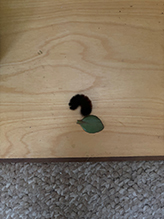 |
In home around plants |
Hanna Wilson |
 |
Temp 35 degrees |
Luciearl |
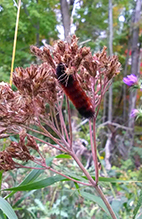 |
Banded woolly bear on Joe pye-weed |
Alfredo Colon |
||
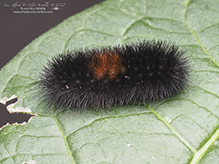 |
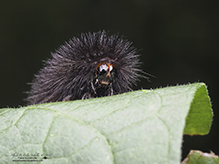 |
|
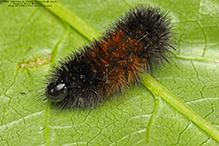 |
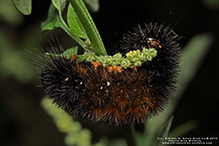 |
|
Greg Watson |
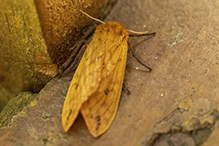 |
Petra |
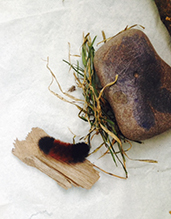 |
Margot Avey |
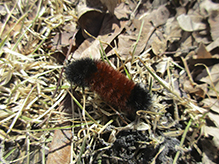 |
krader0225 |
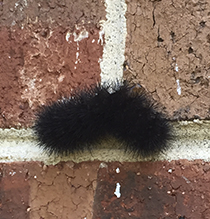 |
Bill Reynolds |
||
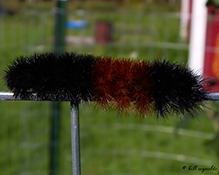 |
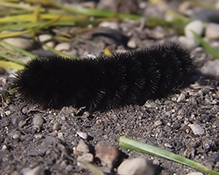 |
|
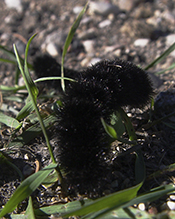 |
||
MinnesotaSeasons.com Photos
|

Slideshows
Isabella Tiger Moth
DianesDigitals
Woolly Bear Caterpillar
Andree Reno Sanborn
Pyrrharctia isabella (Isabella Tiger Moth)
Allen Chartier

Visitor Videos
Share your video of this insect.
This button not working for you?
Simply email us at info@MinnesotaSeasons.com.
Attach a video, a YouTube link, or a cloud storage link.
@annahalo
Woolly Bear Caterpillar!
Oct 21, 2024
Pyrrharctia Isabella. Isabella Tiger Moth Caterpillar!
Sep 25, 2023
Other Videos
Isabella Tiger Moth (Erebidae: Pyrrharctia isabella) Caterpillar
Carl Barrentine
Run, Woolly, Run!
SquirrelOnRoad
Banded Woolly Bear Caterpillar (Pyrrharctia Isabella)
juniortore1
Wooly bear caterpillar (Pyrrharctia isabella)
erminehustler

Visitor Sightings
Report a sighting of this insect.
This button not working for you?
Simply email us at info@MinnesotaSeasons.com.
Be sure to include a location.
@annahalo
10/13/2024
Location: Desbarats, Ontario
@annahalo
9/25/2023
Location: Sault Ste. Marie, Ontario Canada
Peggy Haskin
12/23/2017
Hello: I found a woolly bear caterpillar in my house today. I thought he was dead, but when I touched him he curled up. I'd like to save the little critter, but if I put him outside (it's 20 degrees here today), I'm afraid he'll immediately freeze. I have a small tree planted in a large pot in my house, so I put him on top of the soil. He's crawling around. I looked online and saw directions for "overwintering" him, but it said I should collect leaves from outside to feed him. Well, as you know, there are no leaves outside. Can you give me some advice on what to do with him? Thanks so much.
John Valo
12/23/2017
Maybe put it in a refrigerator with a potted plant (for it to hang from) in the hope that it will create a cocoon and pupate. The cold may be the trigger it needs.
Bill Reynolds
12/17/2015
Location: Pennington Co. MN
… this fall we had tons of Woolly Bear caterpillars crawling about the yard.
Minnesota Seasons Sightings

